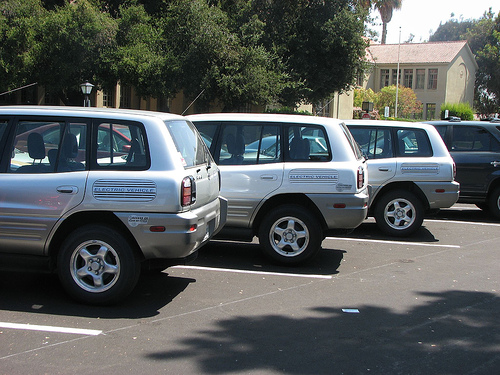CA to boost low-income drivers’ access to electric vehicles
A new bill in California would make the state’s electric vehicle (EV) rebate program more accessible to low- and middle-income drivers, reports Planetizen. It will also provide extra subsidies for low-income families, as well as rebates valid for transit and car-sharing. Currently, EV sales are on the up — albeit not as high as the California Air Resources Board would prefer them to be in order to meet its objective of 1.5 million EVs on the state’s streets by 2025. (That’s more than 15 times the current number.)

California has set high goals for itself in getting people to drive electric vehicles, but it’s going to have to increase incentives to allow lower income people access. From Mike Weston.
California’s Clean Vehicle Rebate Project, which provides incentives of up to $2,500 for battery electric, plug-in hybrid electric, and fuel cell vehicles, hasn’t significantly aided low- and middle-income drivers. The Project, which is directed at individuals, nonprofits, government entities, and business owners, has so far awarded over 50,000 rebates worth about $100 million. Yet those rebates are going to the state’s wealthier residents.
As the Los Angeles Times reports, “Nearly four-fifths of the state rebates went to households earning $100,000 or more, according to a state survey of buyers. Nearly half of those getting rebates for Tesla’s premium electric sedan earned at least $300,000.” The rebate program ran out of funds in April, with approximately 13,500 buyers on a waiting list for rebates, and now lawmakers are hoping to influence low- and middle-income drivers.
Part of the issue is the cost of EVs. Tesla’s Model S costs at least $71,000, with the price stretching beyond $100,000 depending on the features included. Nissan’s Leaf costs from $30,000 to $36,000 — much less than Tesla’s EV, but still $10,000 or more than a gas-run economy car, notes the Times. “A $2,500 rebate to purchase an electric vehicle is not likely to matter to someone earning over $300,000 a year, but it does make a big difference to someone earning $60,000 a year,” Sen. Kevin de León (D-Los Angeles), who wrote the bill, told the Times. “Every community deserves clean air, regardless of wealth.”
The bill would require the state’s Air Resources Board to limit the income of those eligible for the rebate as well as other incentives, with a to-be-determined income limit that “keeps the program in the black but doesn’t slow progress.” The federal government also offers EV buyers a $7,500 tax credit, but even that break is largely unavailable to low-income buyers, as it requires a $7,500 tax liability in order to fully use the credit.
The bill is part of Charge Ahead, a statewide initiative that “aims to place one million light, medium, and heavy-duty electric vehicles on California’s roads over the next 10 years and ensure that all Californians, especially lower-income households in communities most impacted by air pollution, benefit from zero tailpipe emissions.” Charge Ahead also proposes an option for retiring old cars in exchange for credits used for public transit and car-sharing, as opposed to purchasing a new car.
If the bill is passed, EVs would become viable options for low-income families. The Times outlines one scenario:
A family of four with an annual household income of $53,000, for example, could bundle state incentives toward the purchase of a cleaner vehicle. They could get $1,500 for retiring a high-polluting vehicle, along with the existing $2,500 rebate for buying an electric car. The family would also qualify for an additional $3,000 incentive for a clean air vehicle, specifically for low-income buyers. The incentive could be even larger for a buyer who lives in a neighborhood with poor air quality. Alternately, residents could simply retire an older car, without buying a new one, and get $3,000 to pay for a public transit pass or car-sharing program membership.
The bill has already passed the state Senate and must face the Assembly’s appropriations committee by August 31 for final passage before being moved onto the governor for approval.
Category: Automotive

















